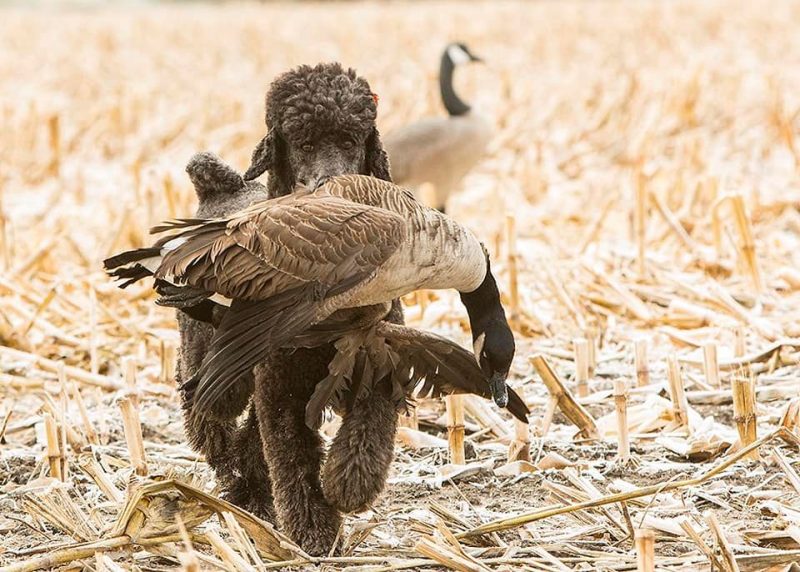
Though the quote has been attributed to Oscar Wilde, George Bernard Shaw and even Winston Churchill, it remains humorously true: Britain and America are two nations divided by a common language.
This was driven home recently in a Facebook thread about hunting with Poodles. Our heart skipped a beat when one reader wrote, “His favourite job was beating.”
Beating???? Who was beating what? Our imagination went to the dark side until mercifully, the writer realized that although she had written her comment in English from the UK, we were reading it in the USA. The same language, different terms meaning the same thing.
She quickly clarified her remark.
What we in America refer to as “flushing” is, in the UK, called “beating.” It is “running the brush” to flush the birds out, or “beating the bush.” Could this be the origin of the phrase, “beating around the bush?
We dug a little deeper into Brit hunting terminology and found a UK based site on hunting. There, we learned that “beaters” are people who flush out birds into the path of the hunters. Though it sounds simple enough, it’s a bit more involved. People who are part of the “beating line” need to move at the right pace so as to allow the shooters to ready their guns. But there can be dogs in a beating line, too, and that is what the writer on Facebook meant by her comment, “His favourite job was beating” referring to the dog.
A beating line is a vital part of a successful shoot, and when dogs are part of the beating line, their primary job is to find and flush game. While all sorts of breeds can be efficient beating dogs, the best ones have reliable recall, are able to work close, and can walk steadily with the line. They have to be able to resist their instinct to chase whatever flies out of the bush, and it’s preferred that they work silently. They have to know not to retrieve what has been shot, and this is why some hunters feel that retrievers aren’t always an asset in a beating line.
There are three things that can embarrass the owner of a “beating dog:” Giving tongue, vanishing into the field in pursuit of a bird, rabbit or deer, or retrieving a shot bird.
The first two embarrassments are understandable to the layperson, but why is bad for a dog to retrieve a bird?
It’s considered poor form because a beating dog’s primary role is to find and flush game, not retrieve it. Retrieving a bird can compromise the dog’s behavior in the beating line, or even unwittingly encourage the dog to chase game which defeats the purpose of the beating line. The dog’s focus has to be on flushing game towards the waiting guns, not picking up shot game which is typically reserved for dogs who have a different role. Being part of a beating line is a demanding role for a dog and requires a high level of steadiness and control. Allowing a dog to retrieve during the beating line can not only interfere with its training and behavior, but it’s beyond irritating to a shooter if a beater dog comes out of nowhere and starts retrieving birds that a hunter has marked.
We came across another phrase which begs for an explanation to “American-English-reading-hunters,” and that is “pegging game.” Evidently, pegging game can be a nasty problem with beating dogs, and habitual peggers are despised by hunters and gamekeepers alike.
What does it mean?
We have found that the meaning can depend upon the source, but by and large, it refers to a dog who retrieves game without permission. It can describe a situation in which an unshot bird, rabbit or hare is found by a dog who picks it up and retrieves it before it has run away or flown off.
We came across a vivid anecdote in a hunting forum where one writer shared how their Labrador “pegged” a crow while it was eating a dead sheep (the crow, not the dog). The retriever returned to his owner with a set of claws buried in her lips and tongue while the crow was making wild pecks at the dog’s eye. The bird went on to grab some hair and skin below the dog’s eye as it held on and tried to pull out even more flesh. To save his dog, the hunter quickly dispatched the crow, but he shared the incident to underscore why a dog with a “pegging problem” is not a good thing. Keepers don’t like pegging not only because it’s one less bird for the hunters to shoot it, but it may be inhumane to the bird. Pegged birds may appear to be fine, but might actually have an internal injury, and thus, many keepers feel it’s best to dispatch the bird quickly rather than to release it to suffer a lingering demise. Perhaps that’s why pegging is an eliminating fault in a field trial, at least in the UK. Might any of our field dog owners weigh in on this?
How confusing this must be to a dog. One moment, the dog is asked to retrieve a runner (a bird that is lightly wounded), the next, the hunter is tearing out their hair over the dog that brings back an unwounded bird.
We conclude by paraphrasing a comment made by someone involved with the Honeycombe Shoot, a hunting event that takes place on nearly 4,000 acres of the Sherborne Castle Estate in Dorset, England. ” Nothing makes a keeper’s job easier than a good team of reliable beaters and picker-ups.”
Photo by Terri Hotchkiss appears with their kind consent
